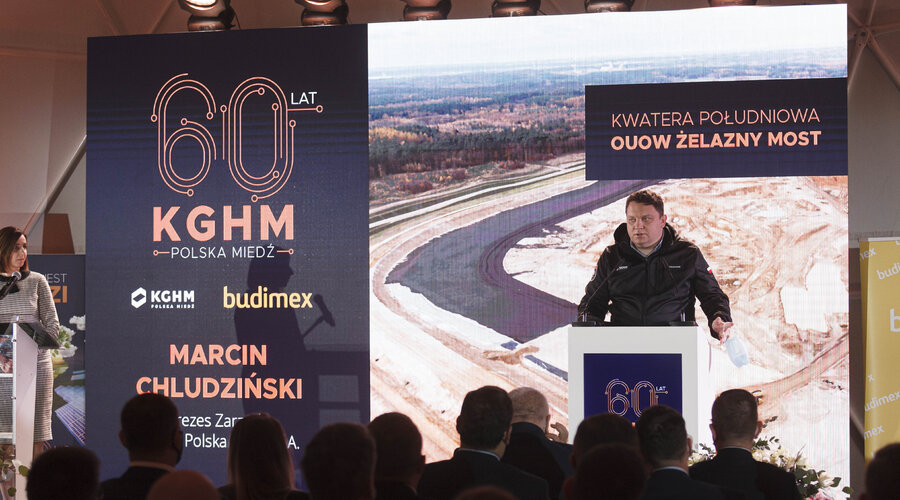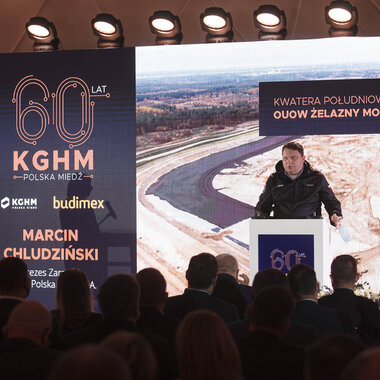KGHM opens the Southern Quarter of the Żelazny Most Tailings Storage Facility, employing innovative solutions for safety and the environment
The Southern Quarter, which is part of the Żelazny Most Tailings Storage Facility, is the largest investment by KGHM Polska Miedź S.A. since 2018. Despite the pandemic, the extension of the facility was completed 7 months ahead of schedule. The Żelazny Most TSF is now the largest and best monitored such facility in Europe and one of the largest in the world. This is a key element in the copper production process.
"These are innovative solutions for the sake of safety. This is a key element in the copper production process. We have taken a giant step towards constantly participating and winning in this global game. Copper has a great time ahead. We are doing everything to make the most of it. Our results, investments such as the Southern Quarter of the Żelazny Most TSF, show that we are doing things right," said the President of KGHM Polska Miedź S.A. Marcin Chludziński.
"I have the honour of supervising the crown jewel of the Polish economy, KGHM. A company that responds to the challenges of the modern world. The opening of the Southern Quarter of Żelazny Most brings the company closer to becoming even more environmentally friendly. As Minister for State Assets, I am proud of KGHM's ability to rise to the challenges, its global reach and its good governance. KGHM is not resting on its laurels, it is constantly expanding, becoming more innovative and modern. The company's profits are record-breaking. The value of KGHM since Marcin Chludziński became its president and since the Ministry of State Assets has supervised the company, has increased by PLN 20 billion," said Deputy Prime Minister and Minister for State Assets Jacek Sasin.
The Żelazny Most TSF, located in Lower Silesia, is the best monitored tailings storage facility in Europe and receives tailings from KGHM Polska Miedź’s plants. Together with the so-called Southern Quarter added to the main facility, it covers an area of over 2,000 hectares. The TSF is surrounded on all sides by earthen dams with a total length of more than 20 km and a height from 54 up to 76 m. The facility receives around 30 million tonnes of tailings per year.
INNOVATIVE TECHNOLOGIES
Due to the significantly smaller surface area of the Southern Quarter compared to the main facility, an innovative compacted waste technology was used there. This is a revolutionary method from the point of view of the development and further operation of the Żelazny Most Tailings Storage Facility. In the main facility, the technology employed involves the silting of deposited material from the center outward. Flotation tailings are delivered from the processing plants by hydro-transport. These tailings, which are suspended in the water, are transported to the TSF through distribution pipelines located along the crown of the facility's dams, from which the tailings are discharged into the facility. The coarse-grained material is used for the superstructure of subsequent layers of the TSF. The fine-grained material seals the bottom of the TSF’s bowl. The facility is built up using only these tailings, without the need for additional materials.
The base dam of the Southern Quarter was constructed using the downstream method. In the dam area of the Southern Quarter, sealing has been carried out and drainage layers built, which ensures that any water leaked from the tailings is captured and returned to the closed loop system. The new technology reduces water loss and infiltration into the ground.
A Tailings Segregation and Thickening Station has been set up at the Southern Quarter to segragate the tailings. The coarse-grained material will be used for the construction of the foundations of the dam while the fine-grained material, after the thickening process, will be deposited within the Southern Quarter. Utilisation of this technology makes efficient use of the facility's surface area and does not require a large basin, but only a small reservoir for the collection of fugitive water from the tailings. By compacting the tailings and, as a result, reducing the amount of water in the TSF, the facility's level of safety will be significantly increased.
HIGHEST SAFETY STANDARDS
The TSF is constantly monitored. The continuous monitoring of the Żelazny Most Tailings Storage Facility encompasses a number of processes that determine the safety of the facility's use and possible threats to adjacent areas and the environment. This monitoring of the the facility and the local surrounding environment in its vicinity includes the examination of precipitation rates, of substances and measured parameters as regards surface water, seepage and groundwater, the measurement of groundwater levels in observation wells, monitoring of the settlement of the TSF’s surface based on established benchmarks, measurement of water seepage volume, monitoring of seismic activity, of the air, soil and plants, animal health and noise. Geological exploration of the vicinity of the Żelazny Most Tailings Storage Facility is also carried out, including field surveys, sampling for laboratory tests, geophysical surveys based on exploratory boreholes, static soundings, open and string piezometers, inclinometers, drainage and relief wells, and electrical resistivity profiles.
For almost 30 years, the facility has been directly supervised by a wide range of experts and scientists participating in regular meetings (Construction Councils) where all issues related to the design, monitoring and expansion of the Żelazny Most Tailings Storage Facility are discussed.
The Żelazny Most Tailings Storage Facility fully protects the natural environment from water accumulating in the retention reservoir. In expanding the facility by the Southern Quarter, the safest option for the construction and sealing of the dams was selected, both from a hydro-technical and environmental point of view. The project was carried out by Budimex, with more than 100 pieces of equipment working on the site, some of which were purchased specifically for this investment. The progress of the work was laser scanned and updated in the BIM system in collaboration with the BIM Innovation Team’s Technical Office.
"The Żelazny Most Tailings Storage Facility is one of the world's largest flotation waste treatment ponds. We used modern technologies to expand it by building the Southern Quarter, which guarantees the safe and efficient use of the facility," said Artur Popko, President of Budimex S.A.










